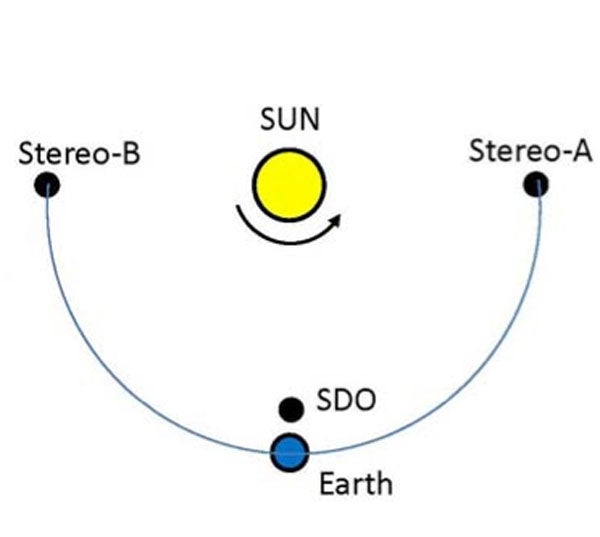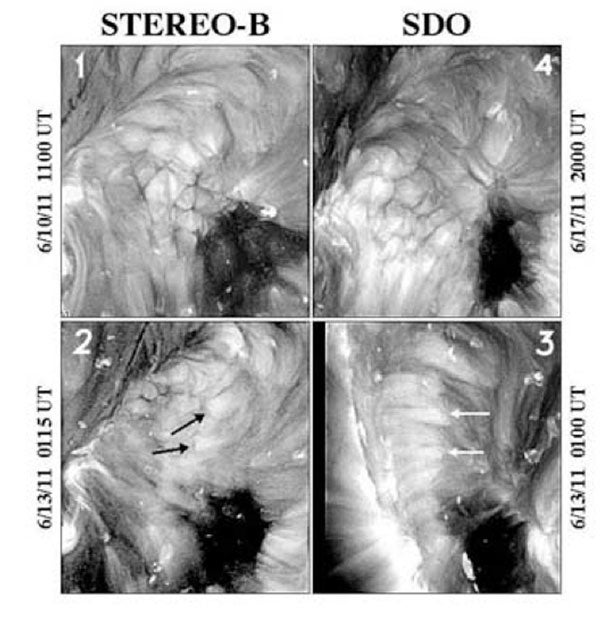But on this day, he saw something he’d never noticed before — a pattern of cells with bright centers and dark boundaries occurring in the Sun’s atmosphere, the corona. These cells looked somewhat like a cell pattern that occurs on the Sun’s surface — similar to the bubbles that rise to the top of boiling water — but it was a surprise to find this pattern higher up in the corona, which is normally dominated by bright loops and dark coronal holes.
Sheeley discussed the images with his Naval Research Laboratory colleague Harry Warren, and together they set out to learn more about the cells. Their search included observations from a fleet of NASA spacecraft called the Heliophysics System Observatory that provided separate viewpoints from different places around the Sun.
The coronal cells occur in areas between coronal holes — colder and less dense areas of the corona seen as dark regions in images — and “filament channels,” which mark the boundaries between sections of upward-pointing magnetic fields and downward-pointing ones. Understanding how these cells evolve can provide clues as to the changing magnetic fields at the boundaries of coronal holes and how they affect the steady emission of solar material known as the solar wind streaming from these holes.
“We think the coronal cells look like flames shooting up, like candles on a birthday cake,” said Sheeley. “When you see them from the side, they look like flames. When you look at them straight down, they look like cells. And we had a great way of checking this out because we could look at them from the top and from the side at the same time using observations from SDO, STEREO-A, and STEREO-B.”
When the cells were discovered in the fall of 2011, the SDO and the two STEREO — short for Solar Terrestrial Relations Observatory — spacecraft each had widely different views of the Sun. Thus, as the 27-day solar rotation carried the coronal cells across the face of the Sun, they appeared first in STEREO-B data, then in SDO, and finally in STEREO-A, before starting over again in STEREO-B. In addition, when one observatory looked down directly on the cells, another observatory could see them from the side.
The researchers used time-lapse sequences obtained from the three satellites to track these cells around the Sun. When an observatory looked down on one of these areas, it showed the cell pattern that Sheeley first noticed. But when the same region was viewed obliquely, it showed plumes leaning off to one side. Taken together, these 2-D images reveal the 3-D nature of the cells as columns of solar material extending upward through the Sun’s atmosphere like giant pillars of gas.
To round out the picture even further, the team turned to other instruments and spacecraft. The original SDO images were from its Atmospheric Imaging Assembly, which takes conventional images of the Sun. Another instrument on SDO, the Helioseismic and Magnetic Imager (HMI), provides magnetic maps of the Sun. The scientists superimposed conventional images of the cells with HMI magnetic field images to determine the placement of the coronal cells relative to the complex magnetic fields of the Sun’s surface.
First of all, the magnetic field bundles lie centered inside the cells. This represents a clear distinction between the coronal cells and another well-known phenomenon known as supergranules. Supergranules also appear as a large cell-like pattern on the Sun’s surface, and their delineated edges are created as the sideways motion of solar material sweeps weaker magnetic fields toward their boundaries. Supergranules, therefore, appear to have enhanced magnetic fields at their edges, while the coronal cells show them at their centers.
The side-by-side nature of these open and closed magnetic fields — open in the coronal holes, and closed in the coronal cells — led to another scientific insight. In some of the movies, a large loop of solar material called a “filament” erupted from the adjacent filament channel. The coronal cells, with their closed field lines, disappeared and were replaced with a dark coronal hole and its associated open field lines.
“Sometimes the cells were gone forever, and sometimes they would reappear exactly as they were,” said Sheeley. “So this means we need to figure out what’s blowing out the candles on the birthday cake and re-lighting them. It’s possible that this coronal cell structure is the same structure that exists inside the coronal holes — but they’re visible to us when the magnetic fields are closed, and not visible when the magnetic fields are open.”
It has long been known that isolated plumes occur intermittently inside coronal holes when very small active regions erupt there. Presumably, these eruptions are providing glimpses of discrete coronal structures similar to the more permanently visible candles adjacent to the holes. When a portion of a hole closes, the candle-like structure is suddenly lit up by the appearance of cells.
In addition to SDO and STEREO, the team went back to historical data on the European Space Agency’s (ESA) and NASA’s Solar and Heliospheric Observatory (SOHO), which provided observations since the previous sunspot minimum in 1996. They did not find coronal cells in 1996 or in the years around the recent sunspot minimum in 2008-2009, but they did find numerous examples of cells in the years around the intervening sunspot maximum in 2000. The recent increase in sunspot activity together with the improved observations from STEREO and SDO may explain why the cells were discovered in 2011.
The team also constructed Doppler images — images that show how quickly and where solar material in the Sun’s atmosphere moves toward the viewer — of the coronal cells using the Extreme-Ultraviolet Imaging Spectrometer on the Japanese Hinode spacecraft. These images show that the centers of the cells move upward faster than their boundaries, further rounding out the physical image of these giant candles with a section rising from the middle.
“One of the wonderful things about SDO is the way the observations can be combined with other instruments,” said Dean Pesnell from NASA’s Goddard Space Flight Center in Greenbelt, Maryland. ” Combining data from SDO, STEREO, SOHO, and Hinode lets us paint a picture of the whole Sun in ways that one instrument can’t.”
The discovery of coronal cells has already increased astronomers’ knowledge of the magnetic structure of the Sun’s corona. In the future, studies of the evolution of coronal cells may improve scientists’ understanding of the magnetic changes at coronal-hole boundaries and their effects on the solar wind and Earth’s space weather.
Solar Coronal Cells as Seen by STEREO
The
changes of a coronal cell region as solar rotation carries it across
the solar disk as seen with NASA’s STEREO-B spacecraft. The camera is
fixed on the region (panning with it) and shows the plumes changing to
cells and back to plumes again — based on the observatory’s perspective
— during the interval June 7-14, 2011.











